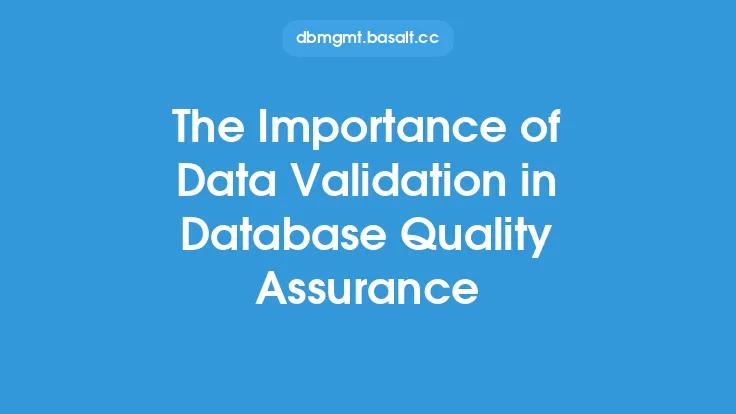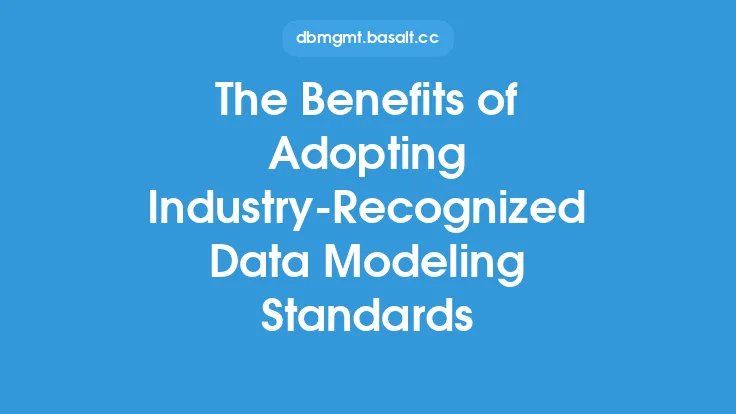In today's data-driven world, organizations rely heavily on high-quality data to make informed decisions, optimize operations, and drive business growth. However, ensuring data quality can be a daunting task, especially when dealing with large volumes of data from diverse sources. This is where automated data quality monitoring and reporting come into play, offering a robust solution to identify, track, and rectify data quality issues in real-time. By leveraging automation, organizations can streamline their data quality processes, reduce manual errors, and improve overall data integrity.
Introduction to Automated Data Quality Monitoring
Automated data quality monitoring involves using specialized software tools to continuously scan and analyze data for errors, inconsistencies, and anomalies. These tools can be configured to check for specific data quality rules, such as data format, data range, and data relationships, and alert users to potential issues. By automating the monitoring process, organizations can ensure that data quality issues are detected and addressed promptly, reducing the risk of downstream errors and improving overall data reliability.
Benefits of Automated Data Quality Monitoring
The benefits of automated data quality monitoring are numerous. Firstly, it enables organizations to identify and fix data quality issues in real-time, reducing the risk of errors and inconsistencies. Secondly, it automates the process of data quality checking, freeing up resources and reducing manual errors. Thirdly, it provides a comprehensive view of data quality across the organization, enabling data stewards to track and analyze data quality metrics and trends. Finally, it enables organizations to improve data governance and compliance by ensuring that data quality standards are consistently applied across the organization.
Key Features of Automated Data Quality Monitoring Tools
Automated data quality monitoring tools typically offer a range of features, including data profiling, data validation, data cleansing, and data certification. Data profiling involves analyzing data to identify patterns, trends, and anomalies, while data validation involves checking data against predefined rules and constraints. Data cleansing involves correcting or removing erroneous data, while data certification involves verifying the accuracy and completeness of data. Additionally, these tools often provide real-time alerts and notifications, enabling users to respond quickly to data quality issues.
How Automated Data Quality Monitoring Works
Automated data quality monitoring works by continuously scanning and analyzing data in real-time. The process typically involves the following steps: data ingestion, data processing, data analysis, and data reporting. Data ingestion involves collecting data from diverse sources, while data processing involves transforming and formatting data for analysis. Data analysis involves applying data quality rules and algorithms to identify errors and inconsistencies, while data reporting involves generating reports and alerts to notify users of potential issues.
Best Practices for Implementing Automated Data Quality Monitoring
To get the most out of automated data quality monitoring, organizations should follow best practices, such as defining clear data quality rules and standards, configuring tools to meet specific business needs, and establishing a data governance framework to ensure consistency and compliance. Additionally, organizations should ensure that data quality monitoring is integrated with existing data management processes, such as data warehousing and business intelligence. By following these best practices, organizations can ensure that automated data quality monitoring is effective, efficient, and aligned with business objectives.
Technical Requirements for Automated Data Quality Monitoring
From a technical perspective, automated data quality monitoring requires a range of skills and technologies, including data management, data analytics, and software development. Organizations should have expertise in data modeling, data warehousing, and data governance, as well as experience with data quality tools and technologies, such as data profiling, data validation, and data certification. Additionally, organizations should have a robust IT infrastructure, including servers, storage, and networking, to support the deployment and operation of automated data quality monitoring tools.
Real-World Applications of Automated Data Quality Monitoring
Automated data quality monitoring has a range of real-world applications, including data warehousing, business intelligence, and data governance. In data warehousing, automated data quality monitoring can be used to ensure that data is accurate, complete, and consistent, while in business intelligence, it can be used to improve the reliability and accuracy of reports and analytics. In data governance, automated data quality monitoring can be used to ensure that data quality standards are consistently applied across the organization, reducing the risk of errors and inconsistencies.
Future of Automated Data Quality Monitoring
The future of automated data quality monitoring is exciting, with emerging technologies, such as artificial intelligence, machine learning, and cloud computing, set to play a major role. These technologies will enable organizations to automate data quality monitoring at scale, using advanced algorithms and analytics to identify and fix data quality issues in real-time. Additionally, the use of cloud-based data quality tools will enable organizations to deploy and operate automated data quality monitoring solutions more quickly and easily, reducing costs and improving agility.
Conclusion
In conclusion, automated data quality monitoring and reporting offer a range of benefits, including improved data accuracy, reduced manual errors, and enhanced data governance. By leveraging automation, organizations can streamline their data quality processes, reduce costs, and improve overall data integrity. As data volumes continue to grow, automated data quality monitoring will become increasingly important, enabling organizations to ensure that their data is accurate, complete, and consistent, and that it meets the highest standards of quality and reliability.





